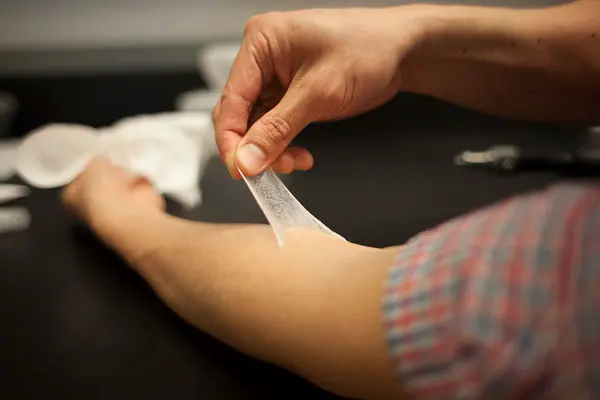New research at the University of California, Berkeley, indicates that the rubber-like elasticity of skin, which contracts to its original shape after being stretched, is key to the development of regularly spaced hairs and sweat glands during development.
The findings, published in a recent issue of Science, come from experiments on how chicken skin generates feathers as the embryo develops inside the egg. They could provide tips on how to grow artificial skin for grafts that looks like normal human skin, complete with hair follicles and sweat pores.
The research, according to the researchers, is the first to link the gentle tug of war among cells as an organism grows to the specific genes that turn on to make cells differentiate into different cell types, turning a generic skin cell, for example, into a specialized follicle cell and eventually a feather.
"The cells of the skin in the embryo are pulling on each other and eventually pull one another into little piles that each go on to become a follicle," said Amy Shyer, a postdoctoral fellow in the UC Berkeley Department of Molecular and Cell Biology.
"What is really key is that there isn't a particular genetic program that sets up this pattern. All of these cells are initially the same and they have the same genetic program, but their mechanical behavior produces a difference in the piled-up cells that flips a switch, forming a pattern of follicles in the skin."
In the study, as first authors, Shyer and Alan Rodrigues, an independent biologist and former UC Berkeley visiting scholar, tested different types of materials on which to grow skin taken from week-old chicken eggs, using artificial substrates that mimic the stiffness of tissues that underlie the skin in the bird.
The skin was obtained from chicken embryos at a time in their development analogous to about one month of gestation in humans, a point at which the human embryo looks the most like other animals, ranging from chickens and turtles to mice and humans, Shyer said.
This is also the point where the rough outlines of internal organs start to differentiate and look like, for example, a heart, lung or liver.
When they transferred a piece of skin, the outer epidermis and the underlying dermis, to these materials, they found that when the cells in the dermis were able to pull strongly against the substrate, they tended to bunch up in numerous evenly spaced spots throughout the skin.
These aggregates squeezed adjacent cells in the overlying epidermis, which activated genes in those cells that made them become a feather follicle. The result: an orderly array of follicles, just like in normal chickens.
When the substrate material was too stiff or too soft for cells to push and pull against, the dermal cells all glommed together into one bunch, squeezing the epidermis to yield just one follicle.
Within the ideal range of substrate stiffness, the stiffer materials produced more closely packed follicles, which could explain the fact that feathers are differently spaced on different parts of the chicken.
"The fundamental tension between cells wanting to cluster together and their boundary resisting them is what allows you to create a spaced array of patterns, in an emergent way," Rodrigues said.
The researchers also discovered that squeezing the epidermal cells jostled a protein, beta-catenin, which normally sits on the surface of the epidermal cell, making it relocate to the nucleus. There it flipped a switch that started the genetic program to make each clump of cells differentiate into a feather follicle.
In terms of application, Rodrigues said, "We have gotten really good at taking stem cells and making them progress into different fates, but we are not good at controlling in a clean way how those cells organize into unique structures as they differentiate."
"They need to adopt the right fate, but also the right architecture ... We are presenting design principles that the embryo is using that could be used to rethink the way we do tissue engineering in a dish, specifically thinking about how the mechanics and the cell fate decisions are working together."
(ASIA PACIFIC DAILY)
 简体中文
简体中文

